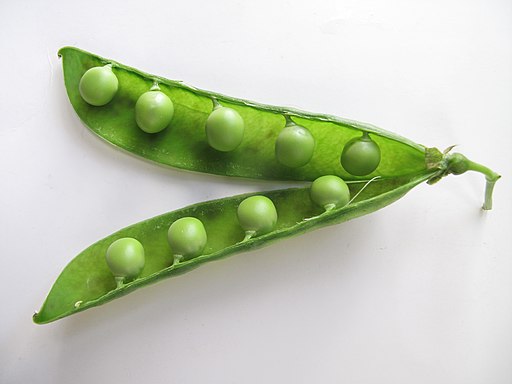门德尔第二次实验
章节大纲
-
What you will learn
::你会学到什么-
What
observed in his second set of
::在他的第二组 -
How the results of these experiments led to the
law of independent assortment
::这些实验的结果如何导致 独立的分类法
Round and green, round and yellow, wrinkled and green, or wrinkled and yellow?
::圆的、圆的、黄的、皱的、绿的、皱的、黄的呢?Can two traits be inherited together? Or are all traits inherited separately? Mendel asked these questions after his first round of experiments.
::两种特征可以一起继承吗? 还是所有特征都是分开继承的? 门德尔在第一轮实验后提出了这些问题。Mendel’s Second Set of Experiments
::门德尔的第二套实验After observing the results of his first set of experiments, Mendel wondered whether different characteristics are inherited together. For example, are purple flowers and tall always inherited together? Or do these two characteristics show up in different combinations in offspring? To answer these questions, Mendel next investigated two characteristics at a time. For example, he crossed plants with yellow round seeds and plants with green wrinkled seeds. The results of this cross, which is a dihybrid cross , are shown in the Figure .
::在观察了第一组实验的结果后,Mendel想知道不同的特征是否一起继承。例如,紫花和高体总是一起继承?还是这两个特征在后代中以不同的组合形式出现?为了回答这些问题,Mendel接下来一次调查两个特征。例如,他用黄色圆形种子跨过植物,用绿色皱纹种子跨过植物。这个十字架(即两栖十字架)的结果在图中显示。This chart represents Mendel's second set of experiments. It shows the outcome of a cross between plants that differ in seed color (yellow or green) and seed form (shown here with a smooth round appearance or wrinkled appearance). The letters R, r, Y, and y represent genes for the characteristics Mendel was studying. Mendel didn’t know about genes, however. Genes would not be discovered until several decades later. This experiment demonstrates that in the F2 generation, 9/16 were round yellow seeds, 3/16 were wrinkled yellow seeds, 3/16 were round green seeds, and 1/16 were wrinkled green seeds. F1 and F2 Generations
::F1和F2代In this set of experiments, Mendel observed that plants in the F1 generation were all alike. All of them had yellow and round seeds like one of the two parents. When the F1 generation plants were self-pollinated, however, their offspring—the F2 generation—showed all possible combinations of the two characteristics. Some had green round seeds, for example, and some had yellow wrinkled seeds. These combinations of characteristics were not present in the F1 or P generations.
::在这一系列实验中,门德尔观察到F1组的植物是相同的,所有植物都有像父母中的一方一样的黄色和圆形种子。当F1组的植物自我授粉时,它们的后代——F2组的后代——展现了这两种特性的所有可能的组合。例如,有些植物有绿色圆形种子,有些则有黄色的皱纹种子。这些特性的结合在F1或P代中并不存在。Law of Independent Assortment
::独立等级法Mendel repeated this experiment with other combinations of characteristics, such as flower color and stem length. Each time, the results were the same as those in the Figure . The results of Mendel’s second set of experiments led to his second law . This is the law of independent assortment . It states that factors controlling different characteristics are inherited independently of each other.
::门德尔重复了这一实验与其他特征的组合,如花色和干干长度。 每次结果都与图中的相同。 曼德尔的第二组实验结果引出了他的第二套法律。 这是独立的分类法。 它指出,控制不同特征的因素是相互独立继承的。What are the missing combinations of genes in the cross below?
::下面十字架上缺少的基因组合是什么?
Summary
::摘要-
After his first set of experiments, Mendel researched two characteristics at a time. This led to his law of independent assortment. This law states that the factors controlling different characteristics are inherited independently of each other.
::Mendel在进行第一组实验后,一次研究两个特征,由此形成了他的独立分类法则,该法规定,不同特征的决定因素是相互独立继承的。
Review
::回顾-
What was Mendel investigating with his second set of experiments? What was the outcome?
::孟德尔用第二组实验调查什么结果? -
State Mendel’s second law.
::孟德尔州的第二项法律。 -
If a purple-flowered, short-stemmed plant is crossed with a white-flowered, long-stemmed plant, would all of the purple-flowered offspring also have short stems? Why or why not?
::如果紫花、短片植物与白花、长片植物交错,那么所有紫花后代是否也都有短片? 为什么或为什么没有?
-
What
observed in his second set of

